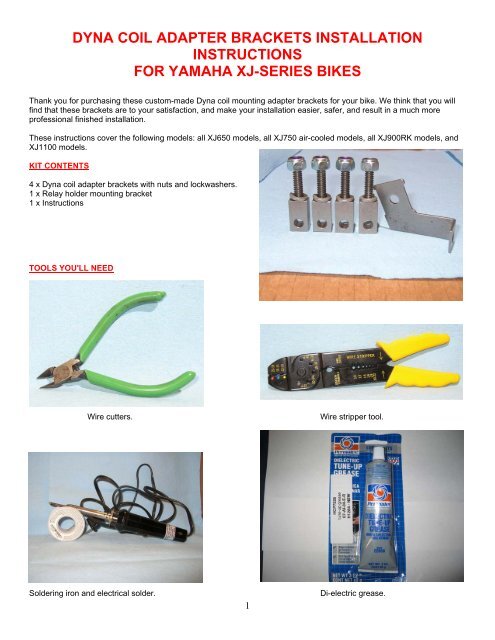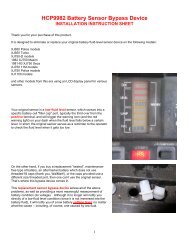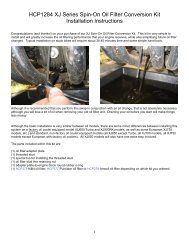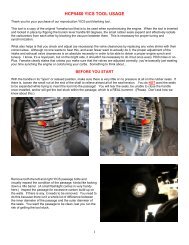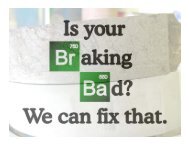Installing Dyna Coils - XJ4Ever
Installing Dyna Coils - XJ4Ever
Installing Dyna Coils - XJ4Ever
Create successful ePaper yourself
Turn your PDF publications into a flip-book with our unique Google optimized e-Paper software.
DYNA COIL ADAPTER BRACKETS INSTALLATIONINSTRUCTIONSFOR YAMAHA XJ-SERIES BIKESThank you for purchasing these custom-made <strong>Dyna</strong> coil mounting adapter brackets for your bike. We think that you willfind that these brackets are to your satisfaction, and make your installation easier, safer, and result in a much moreprofessional finished installation.These instructions cover the following models: all XJ650 models, all XJ750 air-cooled models, all XJ900RK models, andXJ1100 models.KIT CONTENTS4 x <strong>Dyna</strong> coil adapter brackets with nuts and lockwashers.1 x Relay holder mounting bracket1 x InstructionsTOOLS YOU'LL NEEDWire cutters.Wire stripper tool.Soldering iron and electrical solder.1Di-electric grease.
Small sections of suitable size shrink-wrap tubing (preferred...)...or electrical tape (better than nothing).Assortment of hand wrenches and/or sockets(preferably deep) and ratchet, 3/8" drive for the1/4" coil-to-bracket mounting bolts and thehorizontal bracket-to-frame mounting bolts.Pair of pliers and/or small vise grips.2
IntroductionFactory original coils are durable but once they go bad, they can be difficult and very expensive to replace.a) Used original coils that you may find are most probably out of electrical spec, meaning that either their primary orsecondary resistance is beyond acceptable limits. Depending on where the problem(s) with original coils may be, thecondition of used coils may cause poor performance (hard starts, reduced engine output and fuel mileage, etc., especiallywhen cold or wet). They may serve to damage other components in your electrical system, specifically your TCI unit,which is also very time-consuming and expensive to both diagnose and replace.b) Aftermarket high performance coils, such as the green HCP245 <strong>Dyna</strong> brand coils that you have purchased, are anexcellent replacement for the stock factory coils. They produce a much stronger spark than original coils, and while thatmay not translate into any greater acceleration or performance, they will ensure that any other problems your engine mayhave aren’t related to spark performance issues.(Plus they're really cool looking.)c) The drawback to <strong>Dyna</strong> coils is that they are quite a bit bigger than the stock coils, AND that their central mounting barhas its mounting holes oriented (rotated) 90-degrees from those on the original coils.These factors, combined with the incredibly tight space that exists where the factory coils are mounted on the XJ series ofbikes, means one gets to hack together a custom bracket and tweak everything through trial and error... or savethemselves at least some aggravation by purchasing a set of prefabricated mounting brackets, as you have.We must warn you, though: although the use of these custom-made brackets will GREATLY simplify the installation of the<strong>Dyna</strong> coils into your bike, BY NO MEANS does this imply that it will be a "simple" installation. In particular, you will mostlikely have to relocate one (or more) of the electrical relay mounting "tab brackets" that are spot-welded to your frametubes in various positions. These tab brackets were positioned to fit around your original coils, and due to the much largersize and mounting configuration of the <strong>Dyna</strong> coils, there may or probably will be interference problems.We suggest that you take the following issues into account:i) The <strong>Dyna</strong> coils should be installed with the angled spark plug outlet towers facing towards the REAR of the bike,pointed downwards.ii) Any relocated relay tab brackets should be positioned so that the relay that attaches to it is NOT in contact with ANYother object, such as the frame rail. They also need to be positioned so that the factory wiring harness lead wires andterminal will still reach the relay in its new position and that any electrical terminals, etc. will not be in close proximity toANY metal objects. THESE ARE CRITICAL ISSUES. It is much wiser, electrically speaking, to NOT have to splice oradd wiring length whenever possible – doing so adds unwanted resistance to the circuit. The proper place to relocate arelay and its associated tab brackets is a trial and error process on each different model!If things are super tight, it may be possible to very slightly (and carefully!) cut open the main wire harness "wrap tape",where the relay lead wires exit the main harness wrap, to allow the relay harness lead wires a small additional bit of lengthto reach a relay that has been relocated further away.Your coil adapter bracket kit comes with one (1) relay holder tab bracket which can be attached to the coil adapter bracketholder bolts or welded to a frame tube, and will allow the mounting of one relay holder (and its relay). Where and how thebracket is mounted will vary by model.iii) Although the coils themselves do not require an electrical ground path (that is done through the spark plugs), it isnormal, on some models, to find one or more small black ground wire(s) from the main wire harness attached via a ringterminal to one of the original coil bracket mounting bolts, or at the coil mounting bracket on the frame. (Highlighted inyellow below.)4
You should ALWAYS re-attach these ground wire(s). The lack of proper electrical grounding in any DC voltage vehiclecan be responsible for a variety of difficult-to-diagnose and potentially damaging electrical problems.HINT: It is an exceptional idea to take a few moments, while the coils are out of the bike, to carefully sand away any rustor corrosion that is present where this ground wire ring terminal will contact the frame... even removing the paint in thatarea down to bare metal. Then coat the frame area and the ring terminal with a waterproof, electrically conductive greaseor other protective material to ensure both good electrical contact and future corrosion protection.INSTALLATIONYou should expect this job to take a full 2-3 hours for installation, depending on your bike model, and your level of skilland experience at this kind of task.Also, as is common when working in very cramped quarters with numerous sharp metal objects close by, you might incursome physical injuries to your hands and/or other body parts, so be very careful!Also, it is HIGHLY recommended that you have a pen and paper handy when you start this process, as it will be helpful totake notes and/or make simple sketch diagrams as to what goes where when you start taking things apart. (Which wirepair goes to which coil is a good example.) If you have to start unplugging things to move them around, you’ll be glad youtook notes.For the purposes of illustration, we will be using a ratty-looking 1982 750J Maxim.STEPS TO INSTALL DYNA COILS USING THE CABs (COIL ADAPTERBRACKETS)1) DISCONNECT THE BATTERY. Do it! I realize many peoplefeel that they are "extra careful" and it won't matter, becausethey won't ground anything, the key is off, etc. Just do it!The TCI box you save may be your own.5
2) Remove the seat.3) Remove the rear bolt from the gas tank, and on models with an in-tank fuel sender, disconnect the sender wiringharness lead from the main engine harness.Disconnect the fuel and vacuum lines from the petcock, making sure that the fuel petcock is in an "off" position (on manyXJ models this means the petcock selector lever is set to the RES or ON position). Lift up on the rear of the tank, thenslide backwards.Set the gas tank far out of harm's way!6
4) Remove the original spark plug boots/caps and wires from the spark plugs. They pull or "twist" off the threaded stud ontop of the spark plug.For future reference, one coil will have spark plug wires that go to cylinders 1 and 4, and the other coil will have spark plugwires that go to cylinders 2 and 3. It does NOT matter which coil fires which set of cylinders, as long as the wires aregoing to the proper cylinders.From this point forward, we will refer to the coil that fires the #1 and #4 cylinder plugs as the "1-4 Coil" and the coil thatfires the #2 and #3 cylinder plugs as the “2-3 Coil".Cylinders are numbered sequentially as 1, 2, 3, and 4. The #1cylinder is the far left side cylinder (left meaning the clutchlever side of the bike). The #4 cylinder is the far right sidecylinder (near the throttle and front brake lever).5) NOTE the color code of the wires running to each coil, andmake a note of which color pair of wires runs to which coil. Formost XJ model bikes, one set of coil primary lead wires is asolid Orange wire and a Red wire with a white tracer stripe;these are the leads that go to the 1-4 coil. The other coilprimary lead wires are a solid Gray wire and Red wire with awhite tracer stripe, and these go to the 2-3 coil.Detach the coil wiring leads and their plastic terminalconnectors from their corresponding main wiring harnessplastic connectors. Label them.7
6) Remove the original coil mounting bolts from the bike. There will be two M6x80 bolts (6mm, 80mm long), that hold thecoils in place. The front one goes through a “tube”, and the rear goes through an open bracket.Set the coils aside; you will need to remove (cut off) and re-use the original factory coil primary lead wires with theattached plug-in terminal.Set the two mounting bolts, washers, and nuts aside as well; you will re-use these with your new coil adapter brackets.Now is a good time to clean any rust or corrosion from these bolts, and spray paint them with a light coat of paint ifnecessary.7) Now we start on the new coils.a) Cut off the coil primary (input) wires from your original coils as close to the coil as possible. Write down which color pairof wires goes to which coil as explained previously (subtle hint: write it down. Not-So-Subtle hint: WRITE IT DOWN!).Another good idea is to mark the plastic terminal connector with some type of permanent marking method as to which iswhich, i.e. "1-4" and "2-3".b) Install the ring terminals that come with the <strong>Dyna</strong> coils onto the cut-off ends of these wire pairs. We stronglyrecommend soldering the wires to the terminals, as well as crimping, followed by coating with di-electric grease and THENcovered by heat shrink wrap. (A word of advice: don’t forget to put on the heat shrink *before* you crimp and solder thewire. Works much better that way.)8
The preferred procedure illustrated:First, strip about 1/4" off the ends of the (18ga) cut wires. Second, slip on your section of heat shrink tubing and twist.Make sure the wire is shiny for better soldering.Insert the wire into the terminal and TIGHTLY crimp.it in place.After crimping, heat up your trusty soldering iron and getto work.9
Let the solder cool, then slather your work in dielectricgrease.Ease the heat shrink over the connection and hit it upwith a lighter or a heat gun, if you have one.Remember, corrosion is the #1 Enemy of your electrical system!c) Install the primary wiring leads to the <strong>Dyna</strong> coils using the hardware supplied with the coils. You want theseconnections to be tight, but be careful not to over-tighten and strip the fine threaded brass inserts out of the coil bodies!NOTE: For each set of primary input wires, it does NOT matter which color wire goes to which terminal on an individualcoil – the primary input of a coil has no "positive" nor "ground" orientation.10
d) Now, back to the brackets. First up: removing the existing flasher relay mount, highlighted here in red.Leaving this in place is not an option; the new coils will bump up against it.Captain Obvious says, “Take the relay off the mountingbracket first!”There’s no set procedure for doing this, but onesuggestion might be to weaken the weld, then grab thebracket as close to the frame as possible with a crescentwrench and twist back and forth. Either way, get asmuch as you can off,THEN GRIND THE REST FLUSH.If you don’t, depending on which model you have, thebump might still get in the way of the coil.Once that’s done, prep the area, take your trusty can of X-Act Match paint, and make it look all nice and purdy.11
e) We’re about ready for a test fit. You can do this one of two ways. First:The adapter brackets will be installed with the threaded stud pointing downwards. Slide one CAB onto the 80mmmounting bolt, through the front tube, then slide another CAB onto the bolt from the other side. Reinstall the nut fingertight. Do the same for the rear mounting bolt. You should have all four CABs hanging downwards.The coil slides onto the threaded stud, followed by the lockwasher and the nylon locknut. For the purposes of the test fit,you can set aside the lockwasher and locknut and use standard 1/4-20 nuts.The second method would be to mount the CABs to thecoil first, then slide the bolts through the cabs and framebrackets.Did you forget to reinstall any ground wire that wasthere to begin with? If so, do it now!During this trial installation, you will be looking for any fit or interference problems that may occur between the coils andANYTHING ELSE on the bike, including the aforementioned relay mounting tab brackets.This is where you find out what, if anything, needs to be moved, where to move it to, and even how you plan to move it.Chances are, you’ll be fine with removing the one mounting tab and maybe moving some wires out of the way. If you dofind it necessary to start moving things around, be VERY sure that you don’t tug on anything and create a looseconnection.12
WE STRONGLY SUGGEST THAT YOU TAKE YOUR TIME DURING THIS PHASE OF THE OVERALLINSTALLATION PROCESS. You’ve heard the phrase “measure twice and saw once”? Measure two, three, even fivetimes if you have to. Make sure that you account for original relay lead wire harness length and reach to your newproposed locations.It's crowded under there, and you have to be careful to not move pieces to where they will bump into something else!Remember that the gas tank will fit down very tightly, and in very close proximity to the central and side rail frame tubes.ANYTHING OUTSIDE THE SLIGHTLY CURVED GEOMETRIC "PLANE" DEFINED BY THE OUTSIDE EDGE OF THETOP FRAME TUBE, LEADING TO THE OUTSIDE EDGE OF THE BOTTOM SIDE FRAME TUBES, IS OFF LIMITS ASFAR AS A SUITABLE RE-LOCATION AREA, AS THE GAS TANK WILL NOT CLEAR!In other words, anywhereINSIDE the triangledefined by themasking tape can beconsidered fair game.OUTSIDE the triangle......not so much.13
f) Now install the coils onto the FRONT CAB with the supplied 1/4" bolts, flat washers, and lock washers. It is normallyeasiest to install the front of the coils onto/under the front adapter bracket first, and then mount the rear of the coils to therear adapter bracket.As you can see from the lower left-hand picture on page 12, the threaded stud on the CAB fits through the mounting holeon the coil body, and is held in place by the lockwasher and locknut.Again, ideally we’re using spare 1/4-20 nuts for the test fit; for maximum holding power, the locknuts should only betightened down once. Repeated removal and reinstallation weakens the grip of the nylon insert. Finger tighten all of thecoil-to-adapter bracket mounting bolts. Allow the coils to remain a bit loose!Once the two coils are in place, gently put the tank back on and make sure nothing is rubbing. If not, remove the tank andgo to the next step – adding the mounting bracket for the flasher relay.g) As mentioned before, each model of bike is different. Each model has the relay wires exit the wrap at different places,so there’s no given spot to put the new tab bracket. You may need to fiddle with it, bend it some more, flatten it out... itdoesn’t matter where it goes as long as there is NO interference with the tank (or anything else), and NO chance of aconnection shorting to the frame.h) Now, recheck all clearances. Here's where you're on your own, as it differs per bike, and sometimes per year per bike.The factory wasn't always "spot on" in their placement of the original relay tab brackets anyway. Relocate any conflictingpieces to their new locations as needed.NOTE: it is always advised that any relays, when they are relocated, be kept as far away from the engine as is possible,as heat kills.TRIPLE NOTE: if welding is to performed on the bike chassis in order to relocate any tab brackets, then make sure thatthe battery is COMPLETELY DISCONNECTED from the bike’s electrical system.It is also strongly recommended that both plugs to your bike's TCI "Ignitor" unit – the black box "brain" of your ignitionsystem – be disconnected from the main wiring harness during the welding process. Same goes for the regulator/rectifierunit. The TCI unit can become damaged in any number of ways by even the smallest of voltage surges, and damage tothis unit can cause an incredible variety of irregular, difficult-to-diagnose problems of various sorts if it doesn't get friedoutright.i) Once all brackets, relays, etc. are relocated, repositioned, and installed via whatever means necessary, recheck allelectrical connections and tighten down all the nuts and bolts.Then re-check them again. Paranoia pays.A suggestion: before you mount the CABs and newrelay tab bracket for the last time, paint them with yourX-act Match paint to guard against corrosion.14
j) Although you may have marked the coil primary lead wire terminals as to which is which ("1-4" and "2-3"), it is stronglysuggested that also mark each coil BODY in the same way, in a manner that is highly and easily visible.k) Now you will need to install the spark plug wires that you have selected onto the coils, and route them to theappropriate plugs.At this point, you have three options.BUILDING YOUR PLUG WIRESFirst, if you’ve purchased pre-made plug wires from <strong>Dyna</strong>, you can skip this section and go straight to page 17.You can cut/remove the existing plug wires from your old coils, and add the appropriate terminals to plug into the <strong>Dyna</strong>coils – skip ahead to page 18.For the purposes of illustration we will go with option three and build new wires from scratch. The parts/part numbersshown will vary with your given application (depending on which option you go with).Before we begin, a brief note. The wire sections we supply are 18 inches long, which will be too long for the task at hand,more often than not. You may want to consider measuring the length before beginning the build; another option would beto build the coil end of the cables, install them, and then measure and trim the wire lengths to suit.You will need:(4) HCP10671 plug wire sections (4) HCP9746 180-degree coil terminals15
(4) HCP9742 coil boots (2) HCP1300 180-degree NGK plug caps(2) HCP1304 90-degree NGK plug caps (1) HCP9739 plug wire crimping toolStrongly recommended:(1) HCP7528 Dielectric grease (1) HCP9740 Clip-on wire markers16
A set of these “helping hands” won’t hurt, either... or afriend if you can manage it.Got everything? Good. Let’s get started.To make things easier, we’ll put on the coil boots first.Take your dielectric grease and lightly coat the first fewinches of the wire – without the grease, sliding the bootup and down the wire will be a real bear. Put the booton the wire as shown.Step One: Strip the insulation off the end of the wire. To do this, use the middle hole on the crimping tool as shownabove.17
Put the wire in the tool so that about an inch extends past the beveled side of the cutting blades, then squeeze the handleuntil it ratchets. Once it starts clicking, you’re pretty much committed. Squeeze until it stops clicking, then hold; twist thelong part of the wire with the other hand, then pull with the tool.Step Two: Untwist the exposed wire core and fan it out a bit. This will help the wire lay flatter when we solder and crimp.Then bend a section of it over.18
Step Three: Heat up your trusty soldering iron. While it’s warming up, set up your terminal and wire (use a friend ifnecessary). The bend in the wire should be placed about halfway up the terminal, which is about where the cut end of theinsulation will wind up as well. Any more than that, and the wire will have trouble plugging into the coil tower.We’re soldering the wire for two reasons: to promote good conductivity between the terminal and the wire core, and tosupplement the strength of the connection between the terminal and the wire as a whole.Once the iron is nice and hot, press the wires down with the tip onto the terminal body, hold it for a few seconds to heat upthe wires and terminal, and solder the wires in place. Let the piece cool, then fold the plug wire down into the terminal.The cut end of the insulation should just barely extend past the tabs.Step Four: Place the terminal in the crimper so that thelittle arms are pointed up into the little “W” shaped bit.Gently squeeze the handle, making sure the terminalstays put, until you hear the first click. Once you hearthat, go ahead and squeeze as hard as you can until thetool unlatches and lets go.Success! Now do the same with the other three wires.(When I say “squeeze hard”, I mean HARD. This is yourprimary means of making sure the connector stays onthe wire, so crank down on that puppy.Don’t Scrimp On The Crimp.)19
Step Five: Now we do the other end of the wires. Two of them (for the #2 and #3 wires) will use the HCP1300 180-degreecaps.Peel off the boot from the skinny end of the plug cap.Again, lightly grease the last few inches of the plug wireand slide on the boot.The new cap is similar to the stock caps in that theyscrew onto the wire. Once the cap is screwed all theway on, lightly grease the outer surface of the cap, thenslide the boot back into place.The other two wires (for #1 and #4) take the HCP1304 90-degree caps. The installation procedure is the same, exceptthat the boot that fits around the spark plug itself needs to be installed on the cap.And don’t forget, after all is done, to put a multimeter probe on each end of your new wire to check for a good connection.Set your meter to the 1K scale. Without the caps installed, it should read close to zero. With the caps, it should be 5Kohms.20
If you bought our HCP9740 wire markers, clip them onto the appropriate wires, preferably near the plug cap. Having thesewill help if you decide to start pulling plug wires off later, and forget what goes where.Again, just as with the primary input wires to the coil, the individual plug output towers (where the spark plug wiresconnect into the coils) do not "know" (or care, for that matter) which plug wire is plugged into them. The #1 or #4 plug wirecan go to either output tower on the #1-4 Coil, and similar logic applies to the #2 or #3 plug wire on the #2-3 coil. Whydoesn't the coil care? Because the #1 and #4 plugs both fire at the same time, as do the #2 and #3 plugs (but not at thesame time as the #1 and #4 plugs, of course). This is the concept known as “wasted spark”.Next, we install the wires into the coil towers. It’s goingto be a tight fit, so grab the dielectric grease and stick agrunch of it in the hole. Not only does this help you getthe wire in there, it will also help protect the connectiononce it’s installed.If you can’t get the terminal all the way in by hand, usea flat blade screwdriver to push it in the rest of the way.The edge of the terminal should end up right about atthe edge of the coil tower.21
Here’s where the dielectric grease on the wire comes inhandy. Slide the boot up and over the coil tower.Then repeat the process with the other three.(sniff) Isn’t it beautiful? (wipes a tear)Now, we triple-check our connections before we puteverything back on. (Remember, Paranoia Pays.) Grabyour meter and measure from cap to cap. The secondarywinding on the <strong>Dyna</strong> coils has a resistance of 14K ohmsas opposed to the 11K for the stock coils, so if we addthat to the resistance for a pair of 5K plug caps, we get5 + 5 + 14 = 24K ohms.22
We’re pretty much down to final assembly at this point.Put the CABs and the tab mounting bracket onto thecoils, and LOOSELY put the lockwashers and locknutson. Do not tighten anything yet.Mount the CAB/coil assemblies onto the bike with theexisting mounting bolts that you removed earlier. Oncethe coils are in place, snug down the mounting bolts,then do the same with the locknuts on the CABs.Install the flasher relay onto the tab mounting bracket.If you didn’t do it earlier, now’s the time – check thelength of the plug wires and trim them as required.Honey, do these wires make my butt look fat?l) You're basically done. I would like to suggest that you temporarily test your installation work by re-installing the batterycables and anything else that has been disconnected (coil primary leads, TCI unit, relays, etc.) and test-crank the bike.(Come on, you know you want to anyway.) There should be enough fuel in the bowls to fire the bike off. If not, then eitherhook up an auxiliary fuel tank or carefully reinstall your main tank and try starting the bike. Again, at this point in time youmerely want to confirm that the installation of the new coils has been successful enough to get spark to the plugs, and ifthe bike starts and runs for even a few seconds, that is proof that your install has been performed properly, from anelectrical standpoint.m) Now go out and ride with a newfound confidence and power! But do so carefully! While having new <strong>Dyna</strong> coils cangive you self-confidence, inspire awe amongst people and allow you to leap tall buildings at a single bound, you can alsoend up that much more of an attraction for careless, reckless, or inattentive motorists.n) Optional: drink heavily and bandage, or re-bandage, your now bleeding hands... :-)copyright xj4ever.com and Schmuckatelli Heavy Industriesinfo@xj4ever.com23


